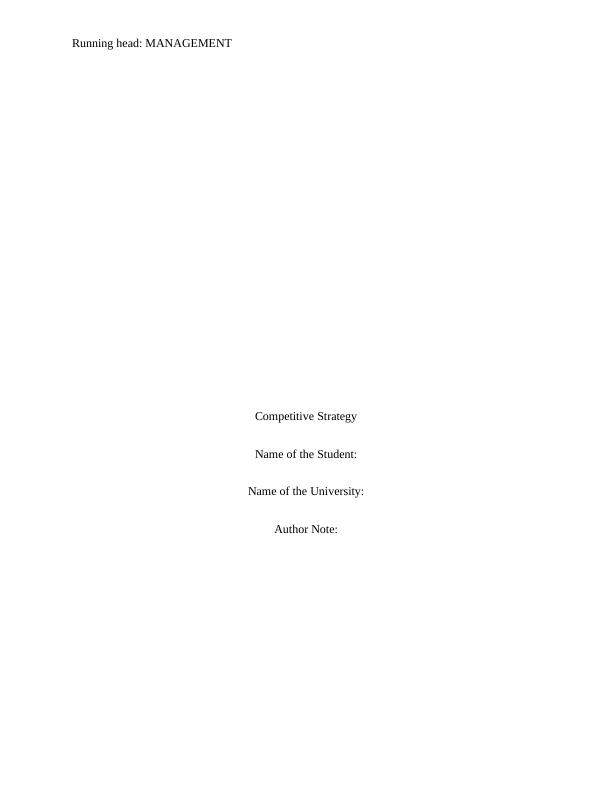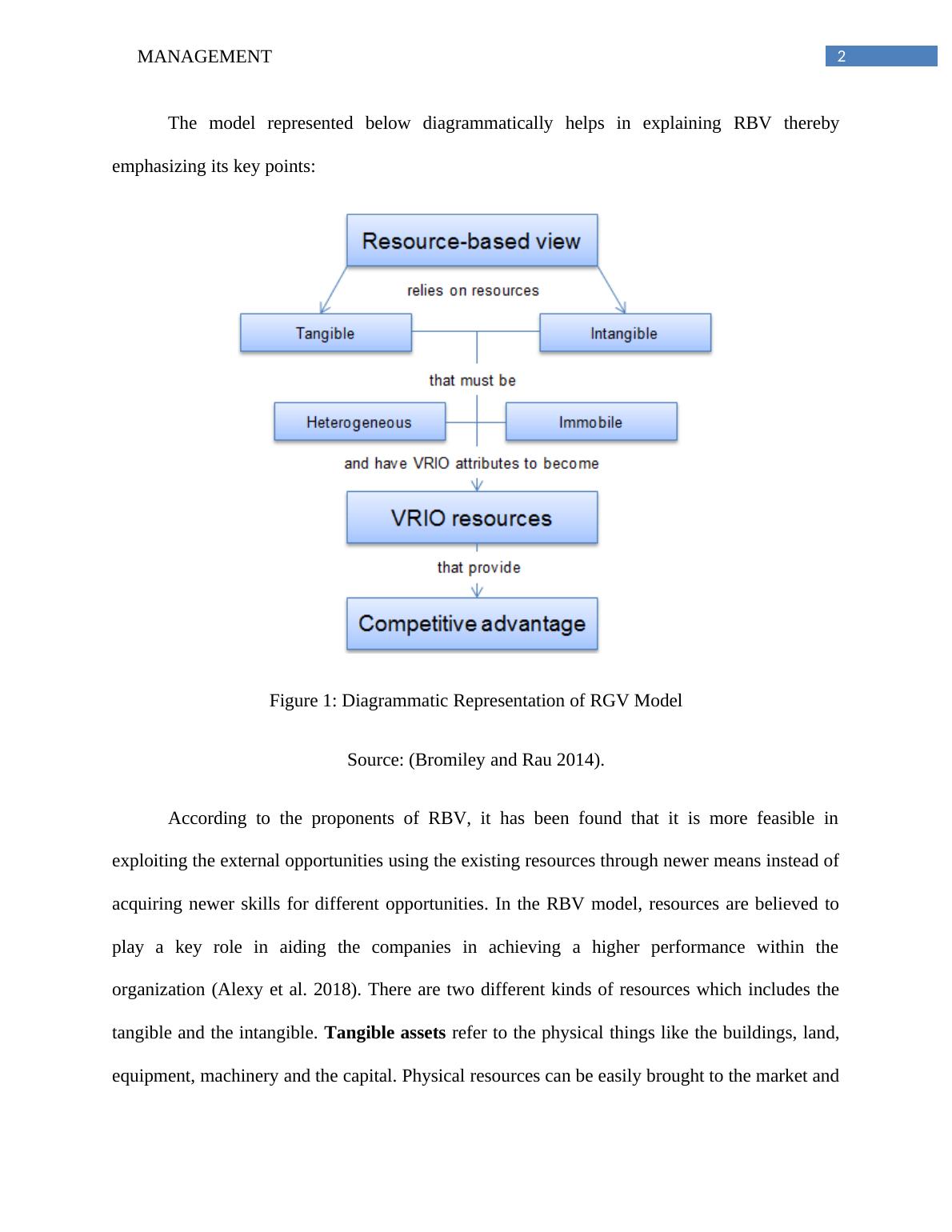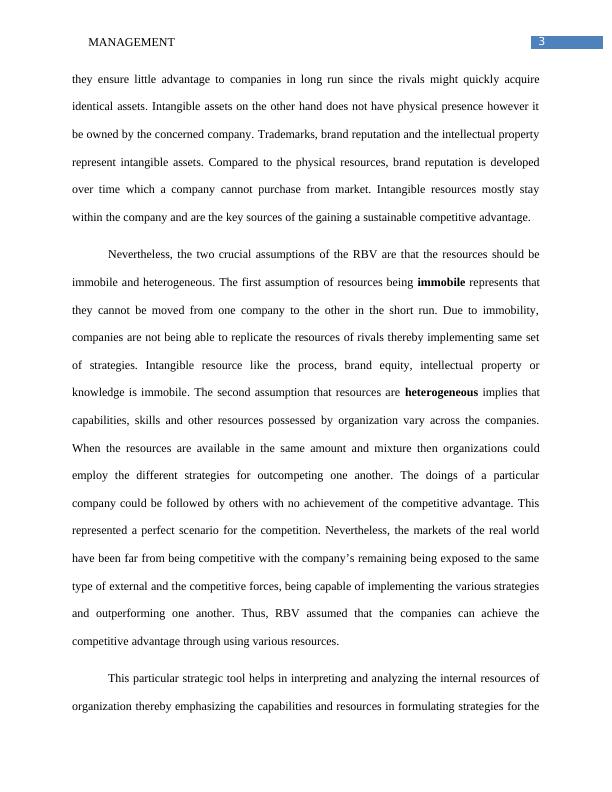Tools of Strategy Development: RBV, Generic Strategies and Ansoff
Added on 2022-10-02
11 Pages2097 Words276 Views
Running head: MANAGEMENT
Competitive Strategy
Name of the Student:
Name of the University:
Author Note:
Competitive Strategy
Name of the Student:
Name of the University:
Author Note:

1MANAGEMENT
Introduction:
The essay aims at providing an insight into the primary tools of the strategy development
and the ways in which they find an application in the business. The basis of good strategy lies in
diagnosing a challenge, develop guiding policy and resulting in the creation of the coherent
actions and policies (Schmeck 2013). It also affects the ways and the allocation of resources that
helps the staff in prioritizing their time. Strategy development also commonly known as the
strategic planning is vital for the creation and the running of the business (Rothaermel 2013). In
other words, it is the game plan that put forward the specific objectives and goals which can be
changed depending on the shifting dynamics of the market. The concept also results in initiating
successful change to a business. There are different tools of the strategy development. This
particular essay focuses on three models Resource Based View, Generic Strategies and Ansoff.
Discussion:
Explanation of the Models:
Resource Based View:
This represents a model that views the resources as the means of superior performance of
the firm. If the resource exhibits the VRIO (valuable, rare, costly to imitate and organized for
capturing value) attributes, then it enables a firm in gaining and sustaining a competitive
advantage (Lin and Wu 2014). Resource Based View (RBV) represents the approach of
achieving the competitive advantage during the 1980s and the 1990s. The supporters of this
particular view argue that organizations must look into the internal aspects for finding resources
that lead competitive advantage instead of looking into the competitive environment.
Introduction:
The essay aims at providing an insight into the primary tools of the strategy development
and the ways in which they find an application in the business. The basis of good strategy lies in
diagnosing a challenge, develop guiding policy and resulting in the creation of the coherent
actions and policies (Schmeck 2013). It also affects the ways and the allocation of resources that
helps the staff in prioritizing their time. Strategy development also commonly known as the
strategic planning is vital for the creation and the running of the business (Rothaermel 2013). In
other words, it is the game plan that put forward the specific objectives and goals which can be
changed depending on the shifting dynamics of the market. The concept also results in initiating
successful change to a business. There are different tools of the strategy development. This
particular essay focuses on three models Resource Based View, Generic Strategies and Ansoff.
Discussion:
Explanation of the Models:
Resource Based View:
This represents a model that views the resources as the means of superior performance of
the firm. If the resource exhibits the VRIO (valuable, rare, costly to imitate and organized for
capturing value) attributes, then it enables a firm in gaining and sustaining a competitive
advantage (Lin and Wu 2014). Resource Based View (RBV) represents the approach of
achieving the competitive advantage during the 1980s and the 1990s. The supporters of this
particular view argue that organizations must look into the internal aspects for finding resources
that lead competitive advantage instead of looking into the competitive environment.

2MANAGEMENT
The model represented below diagrammatically helps in explaining RBV thereby
emphasizing its key points:
Figure 1: Diagrammatic Representation of RGV Model
Source: (Bromiley and Rau 2014).
According to the proponents of RBV, it has been found that it is more feasible in
exploiting the external opportunities using the existing resources through newer means instead of
acquiring newer skills for different opportunities. In the RBV model, resources are believed to
play a key role in aiding the companies in achieving a higher performance within the
organization (Alexy et al. 2018). There are two different kinds of resources which includes the
tangible and the intangible. Tangible assets refer to the physical things like the buildings, land,
equipment, machinery and the capital. Physical resources can be easily brought to the market and
The model represented below diagrammatically helps in explaining RBV thereby
emphasizing its key points:
Figure 1: Diagrammatic Representation of RGV Model
Source: (Bromiley and Rau 2014).
According to the proponents of RBV, it has been found that it is more feasible in
exploiting the external opportunities using the existing resources through newer means instead of
acquiring newer skills for different opportunities. In the RBV model, resources are believed to
play a key role in aiding the companies in achieving a higher performance within the
organization (Alexy et al. 2018). There are two different kinds of resources which includes the
tangible and the intangible. Tangible assets refer to the physical things like the buildings, land,
equipment, machinery and the capital. Physical resources can be easily brought to the market and

3MANAGEMENT
they ensure little advantage to companies in long run since the rivals might quickly acquire
identical assets. Intangible assets on the other hand does not have physical presence however it
be owned by the concerned company. Trademarks, brand reputation and the intellectual property
represent intangible assets. Compared to the physical resources, brand reputation is developed
over time which a company cannot purchase from market. Intangible resources mostly stay
within the company and are the key sources of the gaining a sustainable competitive advantage.
Nevertheless, the two crucial assumptions of the RBV are that the resources should be
immobile and heterogeneous. The first assumption of resources being immobile represents that
they cannot be moved from one company to the other in the short run. Due to immobility,
companies are not being able to replicate the resources of rivals thereby implementing same set
of strategies. Intangible resource like the process, brand equity, intellectual property or
knowledge is immobile. The second assumption that resources are heterogeneous implies that
capabilities, skills and other resources possessed by organization vary across the companies.
When the resources are available in the same amount and mixture then organizations could
employ the different strategies for outcompeting one another. The doings of a particular
company could be followed by others with no achievement of the competitive advantage. This
represented a perfect scenario for the competition. Nevertheless, the markets of the real world
have been far from being competitive with the company’s remaining being exposed to the same
type of external and the competitive forces, being capable of implementing the various strategies
and outperforming one another. Thus, RBV assumed that the companies can achieve the
competitive advantage through using various resources.
This particular strategic tool helps in interpreting and analyzing the internal resources of
organization thereby emphasizing the capabilities and resources in formulating strategies for the
they ensure little advantage to companies in long run since the rivals might quickly acquire
identical assets. Intangible assets on the other hand does not have physical presence however it
be owned by the concerned company. Trademarks, brand reputation and the intellectual property
represent intangible assets. Compared to the physical resources, brand reputation is developed
over time which a company cannot purchase from market. Intangible resources mostly stay
within the company and are the key sources of the gaining a sustainable competitive advantage.
Nevertheless, the two crucial assumptions of the RBV are that the resources should be
immobile and heterogeneous. The first assumption of resources being immobile represents that
they cannot be moved from one company to the other in the short run. Due to immobility,
companies are not being able to replicate the resources of rivals thereby implementing same set
of strategies. Intangible resource like the process, brand equity, intellectual property or
knowledge is immobile. The second assumption that resources are heterogeneous implies that
capabilities, skills and other resources possessed by organization vary across the companies.
When the resources are available in the same amount and mixture then organizations could
employ the different strategies for outcompeting one another. The doings of a particular
company could be followed by others with no achievement of the competitive advantage. This
represented a perfect scenario for the competition. Nevertheless, the markets of the real world
have been far from being competitive with the company’s remaining being exposed to the same
type of external and the competitive forces, being capable of implementing the various strategies
and outperforming one another. Thus, RBV assumed that the companies can achieve the
competitive advantage through using various resources.
This particular strategic tool helps in interpreting and analyzing the internal resources of
organization thereby emphasizing the capabilities and resources in formulating strategies for the

End of preview
Want to access all the pages? Upload your documents or become a member.
Related Documents
Competitive Strategy: RBV, PESTLE Analysis and Porter Five Force Modelslg...
|8
|1839
|406
Root Causes of Organizational Crisis: Resource-Based View and Industry-Based Viewlg...
|8
|1917
|94
Strategic Marketing Evaluation - Assignmentlg...
|21
|5720
|107
Strategic Management : University of Westminsterlg...
|10
|4925
|118
Internal Environment Analysis Assignment 2022 - Deskliblg...
|36
|1884
|381
Projectlg...
|13
|3105
|66
